No honey, mo’ problems
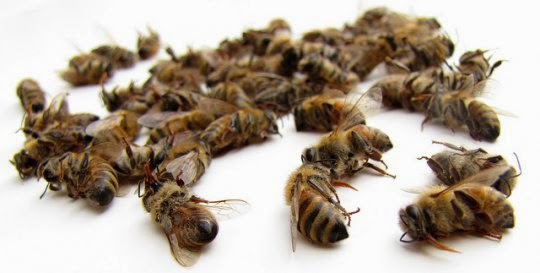
(eattomorrow.com 2014)
The current trend of colony collapse disorder is unsustainable, and if the percentage of honeybee deaths continues to increase then the United States’ and many other countries’ agricultures and economies are in trouble.
“Everyone should know this stuff” Level
Pollination, the process by which plants are fertilized and reproduce, is largely dependent on bees, especially honeybees, the only type of bee cultivated for human use (DJP 2015). Due to their social behavior and hive structure, farmers and beekeepers use honeybees to harvest honey and intensely pollinate a variety of important crops (DJP 2015), such as berries, almonds, apples, and cucumbers (Wellesley 2015). Honeybee pollination is therefore vital to the United States’ agriculture and economy, with honeybee pollination services and honey production amounting to an estimated 15 billion US dollars (33 percent of the US agro-economy) (Wines 2015).
However, over the past decade, a deadly phenomenon, commonly called ‘colony collapse disorder,’ has caused honeybees in the United States and many other countries to leave their hives and die in large numbers (Wines 2015). According to a variety of studies conducted by the Bee Informed Partnership, a collaborative data compilation between various American universities, United States’ beekeepers have been losing drastically increasing percentages of their honeybee colonies every year since 2006, amounting to a 42.1 percent loss in 2015 (Steinhauer, et al. 2015). Although the effects of colony collapse disorder are very prevalent in the United States, its root causes are far less clear (Lewis 2015). However, because colony collapse disorder still has broad effects on farmers, beekeepers, consumers, and the economy as a whole, it is vital that the scientific community identify and find ways to eliminate the variety of stressors that are currently killing honeybees (Wines 2015).
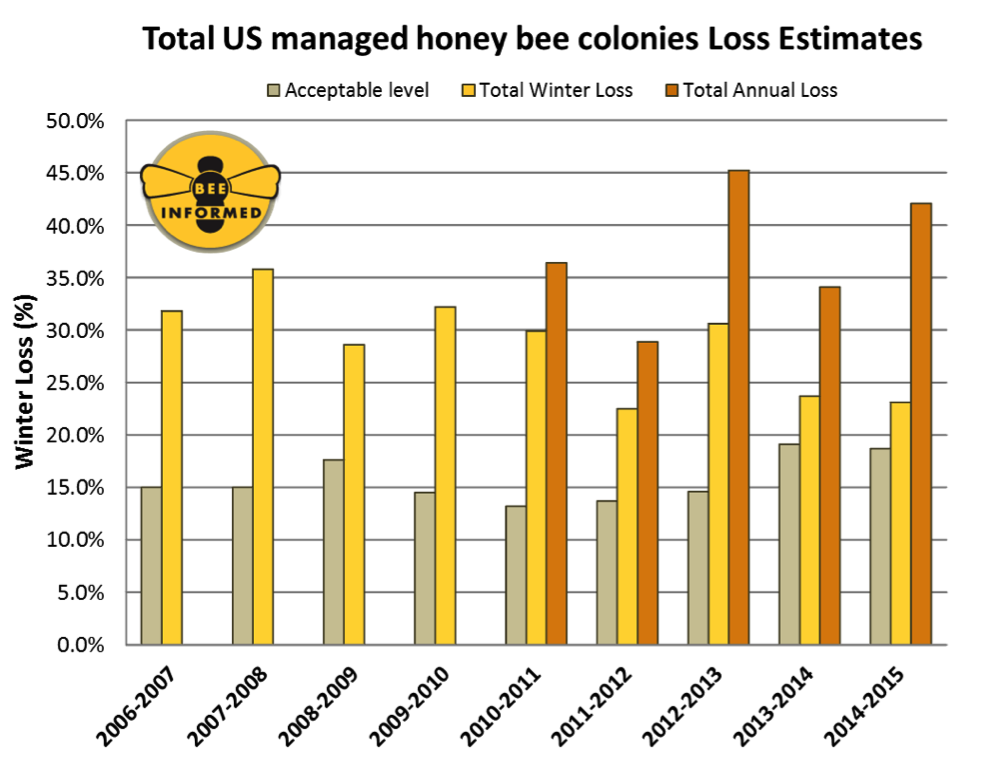
(Steinhauer, et al. 2015)
Multiple studies have demonstrated that three attributes of the current globalized trends of farming and beekeeping are most likely leading to the decline of honeybees: poor nutrition resulting from the loss of arable land for wildflowers, the prevalence of parasites, fungi, and mites that are transmitted from hive to hive, and the usage of increasingly volatile pesticides (DJP 2015). Current research is trying to examine these stressors, but the complex interactions and the variety of changing conditions within honeybee hives have resulted in the scientific community being unable to discern which stressors are most important (DJP 2015). The issue, therefore, remains largely unsolved (DJP 2015).
The most controversial of the three suspected stressors is the use of pesticides and their potential effects on honeybee populations (McDonald 2015). Scientists and governments have focused on neonicotinoids, a widely used class of pesticides that was introduced in 1990 (Aubrey 2015). Various studies have linked neonicotinoid use on flowers and various crops as a cause of queen bee reproductive failure (fewer bees born) and impaired capability in worker bees (Aubrey 2015). However, many pesticide corporations and associated scientists have vehemently denied the suspected effects of neonicotinoids and other related pesticide products (Wines 2015). Richard Rogers, an entomologist at the large neonicotinoid manufacturing firm Bayer Crop Science, claims that neonicotinoids are safe when used properly, and any link between neonicotinoids and colony collapse disorder is due to misuse, not the product (Wines 2015). However, 80 to 95 percent of corn and about 50 percent of soybeans in the US are planted with neonicotinoid-coated seeds, which has led to concerns of overuse (Aubrey 2015). In addition, various independent scientists claim that neonicotinoids are not a major contributor to colony collapse disorder and the scientific community should focus on more concrete issues (Lewis 2015).
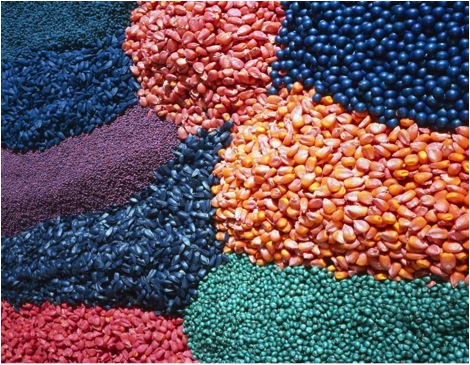
(scientificbeekeeping.com 2012)
Multiple countries have taken precautionary steps against the production and overuse of neonicotinoids (Aubrey 2015). Three variations of neonicotinoids have been banned by the European Commission and the US Environmental Protection Agency (EPA) has committed to not approving any new uses of neonicotinoids until there is further research (Wines 2015). However, there is a potential solution to the controversy surrounding neonicotinoids (Aubrey 2015). Bayer Crop Science is currently creating a specially lubricated seed which will restrict dust from entering the seed and thereby limit neonicotinoid residue from mixing with a plant or the soil and adversely affecting bees (Aubrey 2015).
Although the speculation surrounding the issue of pesticides is the most societally contentious, it is certainly not the most important and it has a much smaller effect on honeybees than the two other stressors (Aubrey 2015). Poor nutrition, however, is undeniably a major component of colony collapse disorder (Wellesley 2015). Because of rising crop prices and falling government subsidies, many farmers have resorted to clearing vast swaths of land that once held wildflowers (Wines 2015). This trend, combined with loss of wildflower arable land due to industrial expansion, robs honeybees of pollen (Wines 2015), which is a vital food source for developing worker bees (Scofield and Mattila 2015).
However, poor nutrition does not cause colony collapse disorder just by starving honeybees (Scofield and Mattila 2015). Wellesley College professor, Dr. Heather Mattila, and undergraduate researcher, Hailey Scofield, recently published a study in PLOS ONE demonstrating links between poor nutrition during honeybees’ larval stage and reduced efficiency, functionality, and lifespans later on in life (Scofield and Mattila 2015). The study demonstrated that bees with early nutritional deficiency (‘pollen-stressed workers’) were lighter and smaller, and therefore could forage (collect pollen and nectar) for less time than non-stressed workers (Scofield and Mattila 2015). In addition, pollen-stressed workers were far less likely to waggle dance (a move depicted in the figure below which signals where the best foraging areas are) (Scofield and Mattila 2015). When they did waggle dance they were not as precise as non-stressed workers (Scofield and Mattila 2015). The study also confirmed that despite a honeybee having sufficient nutrition later in life, early nutritional deficiency still adversely affects its functioning and lifespan (Scofield and Mattila 2015). Foraging and waggle dancing are vital to the health and nutrition of a colony, and therefore lack of efficiency in carrying out these behaviors further exacerbates the nutritional deficiency and population regression in many hives, resulting in colony collapse disorder (Scofield and Mattila 2015).
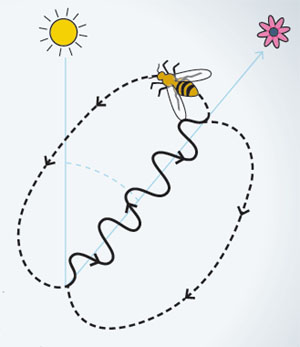
(Schwartz 2014)
Providing more arable land for wildflowers might mitigate the current stressor of poor nutrition, and there are already government initiatives in a variety of countries that aim to designate more land for wildflowers (DJP 2015). United States President Barack Obama, for example, called for 7 million acres of land to be “re-enhanced” for honeybee pollination, such as wildflowers on parks or near roads (Aubrey 2015).
However, many scientists would argue the most important stressor is the increased prevalence of mites and parasites within honeybee hives, especially Varroa mites (Varroa destructor) (Lewis 2015). Varroa mites are parasites that lay eggs in a hive’s brood cells and attach to bees in the larval stage (Lewis 2015). The mites, which are surprising large in relation to honeybees (similar to the size of a basketball to a human), suck the hemolymph (similar to blood) from honeybees and transmit up to 18 different deadly diseases (Lewis 2015). Mites reproduce quickly in hives, and by transmitting diseases they can kill almost all of a hive’s population in a short period of time (Lewis 2015). Although colony collapse disorder remains mysterious due to complex conditions in the hive, many scientists point to Varroa mites as the main cause of the deadly phenomenon (Lewis 2015).
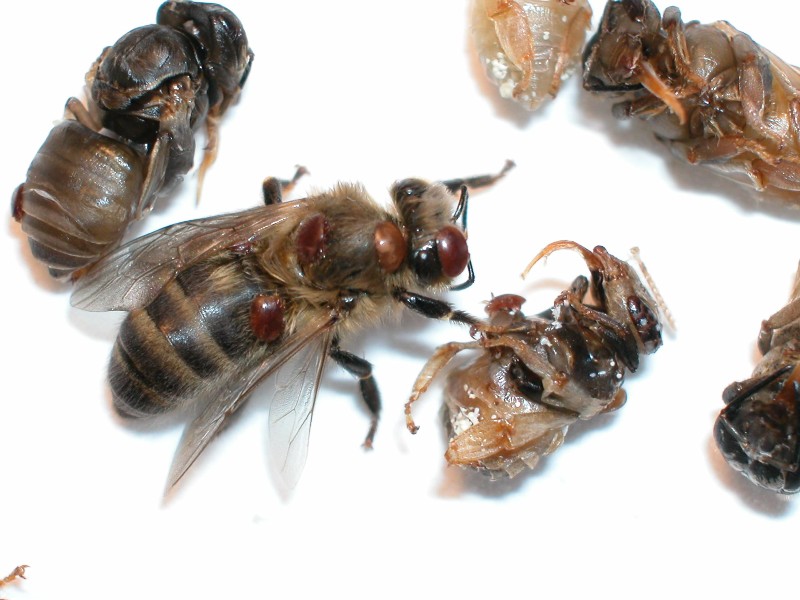
(Adventures In Bee Land 2012)
In addition to Varroa mites, the parasitic microsporidian fungus Nosema ceranae has been shown to infect honeybee larvae and negatively affect honeybee hives, however to a much smaller degree (Eiri, et al. 2015). Although previously thought to only infect adults, a study recently published in PLOS ONE from University of California, San Diego confirmed that Nosema ceranae can infect honeybee larvae and subsequently decrease honeybee life spans (resulting in colony collapse disorder), but can be potentially treated by medication regularly disseminated within a hive (Eiri, et al. 2015).
The current trend of colony collapse disorder is unsustainable, and if the percentage of honeybee deaths continues to increase then the United States’ and many other countries’ agricultures and economies are in trouble (DJP 2015). It is therefore important that the scientific community continue research to determine which stressors are most important and find solutions that adequately incorporate the variety of conditions that interact within honeybee hives (Wines 2015).
“For geniuses only” Level
Unlike the previously discussed external solutions to the issues of poor nutrition, Nosema ceranae, and pesticides, the solution to the issue of Varroa mites involves actual changes in the honeybee population (Lewis 2015). Since 2006, many beekeepers and farmers have been using inefficient methods to combat Varroa mite infestations (Lewis 2015). The most common method is using insecticides to kill Varroa mites, however some mite populations develop genetic resistance and the insecticides can harm the honeybees (Lewis 2015). Other methods have been used to eradicate Varroa mites, such as freezing and sugarcoating (which increases bees’ grooming habits), but all have limited efficacy (Lewis 2015).
However, instead of relying on older, inefficient methods, many beekeepers and scientists are currently turning to discriminatory reproduction in order to emphasize the genetic traits of mite resistant bees (Lewis 2015). Mississippi State University researcher Dr. Jeff Harris has isolated the ‘Varroa Sensitive Hygiene’ trait, which is prevalent in a variety of honeybees (Lewis 2015). Bees with this trait comb the hive for Varroa mites and remove them before they can bind to larvae, thereby stopping Varroa mites from infecting a hive (Lewis 2015).
By isolating honeybees (especially queen bees) with this trait, many scientists and beekeepers are beginning to create mite resistant lines of bees (Lewis 2015). Cultivating these mite resistant lines and making them mate with honeybees without the trait would allow scientists and beekeepers to push the honeybee species into becoming fully mite resistant, thereby mitigating the effects of Varroa mites and combating colony collapse disorder (Lewis 2015). However, in order for the mite resistant lines to have a positive effect on all honeybees, the scientific community needs to urge beekeepers to integrate resistant lines into their existing hives and actively combat Varroa mites to give the resistant trait adequate time to become widespread (Lewis 2015).
Impress your friends and family with these three related facts:
Fact 1: It is estimated that one out of every three mouthfuls of food an American eats is dependent on honeybee pollination (Aubrey 2015).
Fact 2: In 2014, United States President Barack Obama created the Pollinator Task Force, which is charged with finding solutions to colony collapse disorder and other issues plaguing bees (Aubrey 2015).
Fact 3: Honeybees are only one of 20,000 species of bees (DJP 2015).
Author: This page was created by Aiden Reiter, a senior at Choate Rosemary Hall in Wallingford, CT. Aiden’s spirit animal is a hummingbird. Someday, Aiden will be famous for inventing the flying spork – the next great innovation in the field of hybrid cutlery aviation.

Works Cited
Adventures in Bee Land (2012). 3rd Honey bee pests, diseases and poisoning revision post: the lifecycle of Varroa destructor and monitoring & treatment techniques. Adventures in Bee Land Blog. October 21, 2012. Date Accessed: February 22, 2016. http://adventuresinbeeland.com/2012/10/21/3rd-honey-bee-pests-diseases-and-poisoning-revision-post-the-lifecycle-of-varroa-destructor-and-monitoringtreatment-techniques/
Aubrey, A. (2015). As Beekeepers Lose More Hives, Time For New Rules On Pesticides? National Public Radio. November 24, 2015. Date Accessed: February 11, 2016. http://www.npr.org/sections/thesalt/2015/11/24/457130929/as-beekeepers-lose-more-hives-time-for-new-rules-on-pesticides
DJP (2015). The Economist Explains the Decline of Bees. The Economist Explains. September 6, 2015. Date Accessed: February 5, 2016. http://www.economist.com/blogs/economist-explains/2015/09/economist-explains-2
Eat Tomorrow. (2014). What Colony Collapse Means For Our Food Supply. eattomorrow.com. September 14, 2014. Date Accessed: February 18, 2016. https://eattomorrow.com/blog/2014/09/colony-collapse-means-food-supply/
Eiri, D., G. Suwannapong, M. Endler, J. Nieh. (2015). Nosema ceranae Can Infect Honey Bee Larvae and Reduces Subsequent Adult Longevity. PLOS ONE. May 27, 2015. Date Accessed: February 17, 2016. http://journals.plos.org/plosone/article?id=10.1371/journal.pone.0126330
Lewis, KC (2015). Bee health complexity requires scientific solutions. Mississippi State University Office of Agricultural Communications. June 17, 2015. Date Accessed: February 3, 2016.http://msucares.com/news/print/agnews/an15/20150617_3.html
Scofield, H., H. Mattila (2015). Honey Bee Workers That Are Pollen Stressed as Larvae Become Poor Foragers and Waggle Dancers as Adults. PLOS ONE. April 8, 2015. Date Accessed: February 17, 2015. http://journals.plos.org/plosone/article?id=10.1371/journal.pone.0121731
Steinhauer, N., K. Rennich, K. Lee, J. Pettis, D. Tarpy, J. Rangel, D. Caron, R. Sagili, J. Skinner, M. Wilson, J. Wilkes, K. Delaplane, R. Rose, D. vanEngelsdorp (2015). Colony Loss 2014-2015: Preliminary Results. Bee Informed Partnership. May 13, 2015. Date Accessed: February 15, 2016. https://beeinformed.org/results/colony-loss-2014-2015-preliminary-results/
Schwartz, H. (2014). Waggle Dancing. harryrschwartz.com. July 2, 2014. Date Accessed: February 22, 2016. http://harryrschwartz.com/2014/07/02/waggle-dancing.html
ScientificBeekeeping.com (2012). Neonicotinoids: Trying To Make Sense of the Science – Part 2. scientificbeekeeping.com. September, 2012. Date Accessed: February 23, 2016. http://scientificbeekeeping.com/neonicotinoids-trying-to-make-sense-of-the-science-part-2/
Wines, M. (2015) A Sharp Spike in Honeybee Deaths Deepens a Worrisome Trend. The New York Times. May 13, 2015. Date Accessed: February 2, 2016. http://www.nytimes.com/2015/05/14/us/honeybees-mysterious-die-off-appears-to-worsen.html?_r=1

Leave a Reply